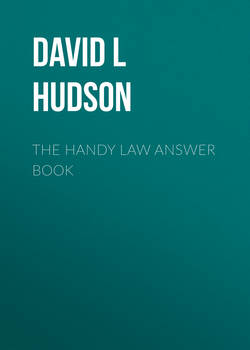Читать книгу The Handy Law Answer Book - David L Hudson - Страница 106
На сайте Литреса книга снята с продажи.
What is the level of free speech protection for public employees?
ОглавлениеPublic employees have First Amendment rights but they are limited by the employment relationship. In one decision, Garcetti v. Ceballos (2006; see LegalSpeak, p. 54), the U.S. Supreme Court ruled that public employees do not have free-speech protection for speech made pursuant to their official job duties. However, if a citizen speaks more as a citizen than an employee, the courts will apply a two-part test from Pickering v. Board of Education (1968) and Connick v. Myers (1983). That test asks: (1) Did the employee’s speech touch on matters of public concern or importance; and (2) does the employee’s right to free speech trump the employer’s right to an efficient, disruptive-free workplace.
LegalSpeak: Virginia Pharmacy Board v. Virginia Consumer Citizens Council
The U.S. Supreme Court decision on Virginia Pharmacy Board v. Virginia Consumer Citizens Council (1976) read, in part, as follows:
Here, in contrast, the question whether there is a First Amendment exception for “commercial speech” is squarely before us. Our pharmacist does not wish to editorialize on any subject, cultural, philosophical, or political. He does not wish to report any particularly newsworthy fact, or to make generalized observations even about commercial matters. The “idea” he wishes to communicate is simply this: “I will sell you the X prescription drug at the Y price.” Our question, then, is whether this communication is wholly outside the protection of the First Amendment….
As to the particular consumer’s interest in the free flow of commercial information, that interest may be as keen, if not keener by far, than his interest in the day’s most urgent political debate. Appellees’ case in this respect is a convincing one. Those whom the suppression of prescription drug price information hits the hardest are the poor, the sick, and particularly the aged. A disproportionate amount of their income tends to be spent on prescription drugs; yet they are the least able to learn, by shopping from pharmacist to pharmacist, where their scarce dollars are best spent. When drug prices vary as strikingly as they do, information as to who is charging what becomes more than a convenience. It could mean the alleviation of physical pain or the enjoyment of basic necessities. Generalizing, society also may have a strong interest in the free flow of commercial information….
There is, of course, an alternative to this highly paternalistic approach. That alternative is to assume that this information is not in itself harmful, that people will perceive their own best interests if only they are well enough informed, and that the best means to that end is to open the channels of communication rather than to close them. If they are truly open, nothing prevents the “professional” pharmacist from marketing his own assertedly superior product, and contrasting it with that of the low-cost, high-volume prescription drug retailer. But the choice among these alternative approaches is not ours to make or the Virginia General Assembly’s. It is precisely this kind of choice, between the dangers of suppressing information, and the dangers of its misuse if it is freely available, that the First Amendment makes for us.
Do young students have the same rights to free speech as adults? Recent Supreme Court decisions have held that they do not (iStock).
A problem in this area is that it is unclear when an employee is speaking pursuant to their official job duties. Sometimes a public employee may speak both as an employee and as a concerned citizen. Many courts look to the “core functions” of an employee’s job and try to determine whether the speech is required by the job.
